Castles in Ayrshire
East Ayrshire
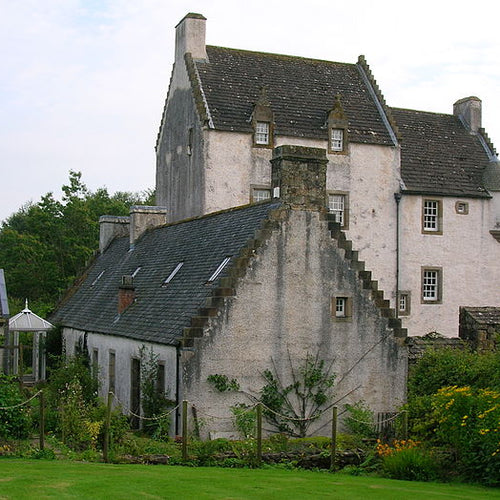
Aiket Castle
A 15th Century Tower House build for the Cunninghames in the parish of Dunlop, gutted by a fire in 1957 it has been fully re-stored by the present owners.
Your link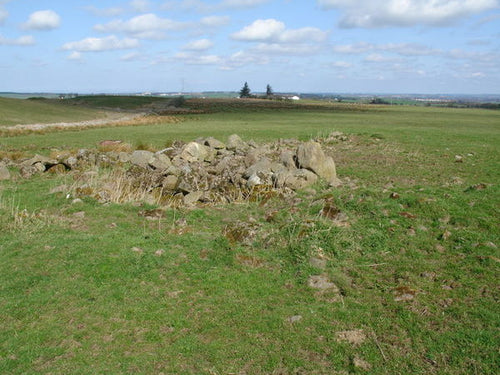
Auchencloigh Castle
Auchencloigh Castle or Auchincloigh Castle is a ruined fortification near the Burnton Burn, lying within the feudal lands of the Craufurd Clan, situated in the Parish of Ochiltree, East Ayrshire.
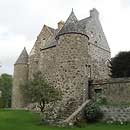
Barr Castle
An old Norman keep built by the Lockhart family after an invasion of Anglo-Norman people in the 12th and 13th centuries. George Wishart 1545 and John Knox 1556 the Scottish reformers both preached here as the church doors were locked against them. Home of Lodge St Peter 331 for over a hundred years.
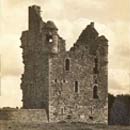
Busbie Castle
Busbie Castle was situated in what is now known as Knockentiber (Scottish Gaelic: Cnoc an Tobair, hill of the well), a village in East Ayrshire, Parish of Kilmaurs. The castle overlooked the Carmel Glen and its Burn, which runs into the River Irvine, a mile or so to the south, after passing through the old Busbie Mill. The castle was a ruin since at least the 1770s and was demolished in 1949 or 1952 as it had been unsafe for many years and the funds were not found to consolidate the structure.
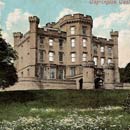
Caprington Castle
Caprington Castle is located less about 2 miles from Kilmarnock in Ayrshire. The building is now a mansion with battlements – the original keep, and the original turnpike stair are incorporated into the current building. Caprington Castle has been the Cuninghame family for many generations. The earliest parts of the castle date from the 15th or 16th centuries. The castle was remodelled in Georgian style around 1780. Further renovations were carried out around 1820 in a baronial style.
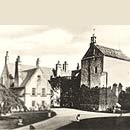
Cessnock Castle
Cessnock castle near Galston, East Ayrshire dates from around the 15th Century. The Duke of Portland had it restored by 1900 and is now a private house.

Corsehill Castle (also called Ravenscraig)
The old Barony and castle of Corsehill lay within the feudal Baillerie of Cunninghame, near Stewarton, now East Ayrshire. Corsehill Castle was first held by the De Ross family fro Dunlop Castle, later by the Cunninghame family linked to the Earl of Glencairn. A new Corsehill House was built to the east of the old castle and this was in turn abandoned when the Montgomery-Cunninghames
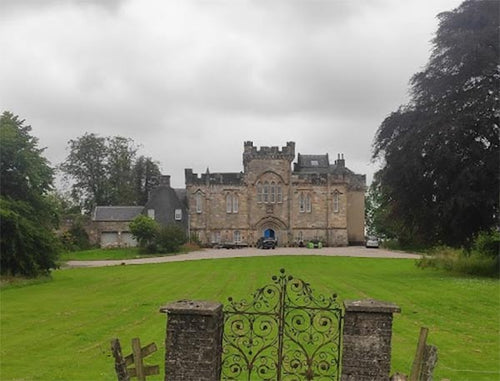
Craufurdland Castle
The castle dates from 1245, one of the oldest in Ayrshire. It was the home to the Craufurds of Craufurdland since. Craufurdland Castle is split into two apartments, the Tower House, a luxury self catering apartment for up to 16 people, and the Laird’s House, next door, where the current laird lives. Interesting features include the remains of a secret passageway in the laird’s room.
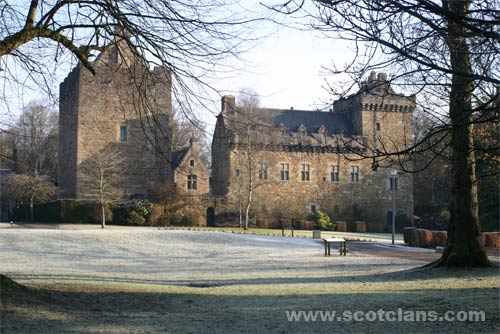
Dean Castle
Dean Castle was the home of the Boyds, Lords of Kilmarnock. They were given their lands by King Rober I (The Bruce) in 1316, and lived there till the castle was destroyed in an accidental fire in 1735. Not long after, the estate was sold by the Boyds and had various owners till it passed to Lord Howard de Walden in 1828. The ruined castle was restored by the 8th Lord Howard de Walden between 1908 and 1936, and presented to the people of Kilmarnock by his son in 1975. The high keep which stands on it’s own was built first – about 1350. This was for defence, with walls 2-3 metres thick, few windows, and the original main entrance high above the ground. There are no arrowlits in the walls, all the shooting was done from the top. The other part of the castle is mall palace built by Robert Boyd, about 1460, together with the attached tower and the wall surrounding the courtyard. The gatehouse and the roofed walk round the top of the courtyard wall are modern, otherwise the buildings are authentic and give a fair idea of the original appearance of a typical Scottish Castle.

Dunlop Castle
Dunlop is a village and parish in East Ayrshire. It has traditionally been believed that De Ross first held Boarland or Dunlop Hill as their seat and a well-fortified structure existed there, later their seat was moved to Corsehill in Stewarton. A Celtic hillfort may have existed here, as suggested by the etymology of the placename. In 1848 it was recorded that ‘ a number of years ago the foundation of a ruin of considerable extent was removed by the late proprietor’. Since then, the ruins of a building of considerable extent have been removed and the ground cultivated. Pont states that the ancient strong Dunlop Castle situated by the Clerkland Burn was protected by a moat or fosse of water and had ‘goodly’ orchards. Smithn records that the ‘Airn Yett’ of the old castle was still preserved and its details published. It was also called Hunt Hall because the Dunlops were huntsmen to the De Ross family (Paterson 1866). The whole estate was sometimes referred to as Hunt Hall. This castle was situated at the site of the present day Dunlop House.
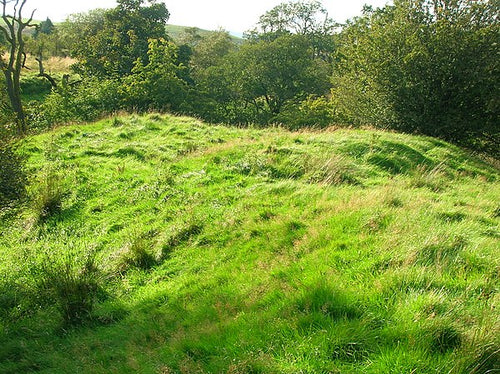
Kerse Castle (Also known as Carse Castle)
Kerrie Castle is a ruined fortification once held by the Craufurd Clan, situated in the Parish of Dalrymple. Nothing now remains. It is unknown what this castle would have looked like. The Craufurds of Kerse were a cadet branch of the Craufurds of Loudoun, and ultimately became the representatives of the Dalmagregan Crawfords, carrying in their armorial bearings a stag’s head, as did also the Craufurds of Drumsoy and the Craufurds of Comlarg. The spelling ‘Craufurd’ is adopted here.

Kilmaurs Castle
Kilmaurs Castle was located on the lands of Jocksthorn Farm near Kilmaurs in East Ayrshire. This was an early 17th Century Castle that belonged to the Earls of Glencairne. Some ruins of this castle have been found on the farm of ock’s-thorn, probably the original Villam de Cuninghame – the first possession of the family.” The castle is not to be confused with the later Cunninghame family possession known as Kilmaurs Place which Dobie calls “..comparatively modern” in 1876
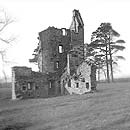
Kingencleugh Castle (Also known as Kingenclough)
The remains of the old castle lie close to east of the town of Mauchline. From the remains, this appears to have been built as a dwelling with defence as a secondary consideration. John Knox is said to have visited it in 1556. Kingencleugh was built as one of several castles built as border markers for the Campbell feus in the area. Kingencleugh latterly became part of the Ballochmyle estate. The present castle was built around 1620 to replace the older fortification that Knox would have known. The castle was abandoned once the new house was built. The Campbells held the property until the end of the 18th century. Kingencleugh was the residence successively of Hugh and Robert Campbell, both ardent reformers. George Wishart and John Knox were entertained here and Knox also preached at this castle when he visited Mauchline in 1556. On his death bed it was to Robert Campbell that Knox said: “I rely on you becoming to them (his wife and children) as a husband and a father in my room.” Dobie records that John Knox was conducted by Lochhart of Bar and Campbell of Kineancleugh to Kyle, the ancient recaptacle of the Scottish Lollards, where there were a number of adherents to the reformed doctrine. He preached in the houses of Bar, Kineancleugh, Carnell, Ochiltree, and Gadgirth, and in the town of Ayr. In several of these places he also dispensed the Sacrament of Our Lord’s Supper.
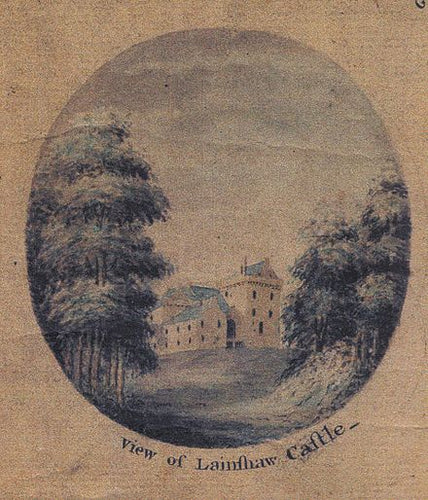
Lainshaw Castle
Lainshaw House is now built on the location of the older Castle. One of the earliest references to Lainshaw, Langshaw or Langschaw is the grant of land to Alexander Home of Holme by King James II in 1450. Castleton, Gallowberry, Whitelee, Crennachbrare, Robertland and Magbiehill (Magby Hill in 1775) were also included in the grant. Thomas Home inherited, but he died without issue and it passed to the Eglinton family, namely Sir Neil or Nigel Montgomerie of Langshaw who was the third son of the first Earl of Eglinton. He was killed at Irvine in 1547 through the feud with the Mowats of Busbie and Lord Boyd. His son, John, married Margaret, daughter of Lord Boyd. John Montgomerie died without issue and his brother Neil became the third Laird. Neil Montgomerie married the heiress of Lord Lyle and had a son, Neil, who died before 1621. The son, Neil, had married Elizabeth, daughter of John Cunningham and had four children, Neil of Lainshaw, William of Bridgend, James of Dunlop, and John of Cockilbie. Neil and his son John sold their estates in 1654 to John of Cockilbie. In 1745 the Laird of Langshaw died suddenly from drinking bad wine. When the 9th Laird, James, died in 1767 his eldest sister, Elizabeth inherited. She had married Alexander Montgomerie-Cuninghame of Kirktonholme, son of Sir David Cuninghame of Corsehill. Her second husband was J. Beaumont Esq. The 10th Laird was their son, Sir Walter Montgomerie-Cuninghame, who lost a fortune as result of the American War of Independence. William Cunninghame of Bridgehouse and (afterwards Lainshaw), the ‘Tobacco Lord’, had made a fortune in America between 1748 and 1762. In 1776 ‘Linshaw’ is shown on road map as occupied by Bowman Esq. In 1779 William Cunninghame purchased Lainshaw from Sir Walter and proceeded to improve the Estate under an agreement whereby the Montgomeries could reclaim the estate only if they could reimburse William for the cost of his improvements. They were never able to do so. William married three times and had fourteen children. He disinherited his eldest sons Thomas and Alexander and it was his third son, William Cunninghame who inherited the estate in 1799, but did not take up residence until 1804. During his time the house was remodelled extensively. He was a religious eccentric, which led to various court actions and his publishing a wide range of eccentric books, including one against swearing. He never married, having heard his childhood sweetheart utter unacceptably bad language. On his death in 1849, the estate passed to his younger half brother, John Cuninghame of Duchrae, who in turn was succeeded in 1864 by his son John William Herbert, a Captain in the 2nd Life Guards and married in 1867 to Emily, eldest daughter of Major George Graham

Loch Doon Castle (Balloch Castle)
Loch Doon Castle was a castle that was located on an island within Loch Doon. It dates back to the 13th Century. The castle was dismantled and rebuilt on the side of the loch after the loch water level was raised in the 1930s for a hydro electric scheme. In 1306 Sir Christopher Seton, brother-in-law of Robert the Bruce, sought refuge at Loch Doon after Bruce’s army was defeated at the Battle of Methven. When Seton came to Loch Doon the castle was controlled by a hereditary governor, Sir Gilbert de Carrick. The hereditary nature of the governorship suggests that the castle was built by an earlier Earl of Carrick, an ancestor of Bruce himself. In 1333 Loch Doon was one of only 5 castles in Scotland to uphold the cause of David Bruce to the Scottish throne following defeat at the Battle of Halidon Hill. The English besieged the castle in 1335 but the defenders were able to hold out. Another unsuccessful attack came in 1510 when William Crawford of Lochmores tried to capture Loch Doon as part of an ongoing feud with the Kennedy family owners. No one knows for certain when the castle passed out of use. One unconfirmed suggestion is that it was destroyed by fire during the reign of James V (1513-1542). One source suggests that the iron portcullis that used to defend the entrance is now at the bottom of the loch. When the castle was moved to the shore, the 16th century keep was left behind, so the current site consists almost entirely of the 14th century wall, with remains of interior foundation walls. In 1823 six dug-out canoes were discovered near the castle gate. One of the boats contained a Viking battle-axe, which can now be seen in the Kirkudbright Museum, while two of the boats are in the Hunterian Museum in Glasgow. Historians have speculated that the canoes were used during construction of the castle.

Mauchline Castle ( also known as Abbot Hunter’s Tower)
Mauchline Castle, is a rectangular tower house dating from the fifteenth century, in Mauchline. Before 1177 the Cistercian Melrose Abbey held lands in Ayrshire, virtually represented by Mauchline parish. The castle was constructed by monks from Melrose Abbey in about 1450. The arms of Abbot Hunter (c1444-71) on a boss in the vaulting of the first-floor hall give the earliest dating of the Castle. Huw Campbell of Loudoun was appointed Bailie of Barony in 1521, gaining the temporal lordship in 1606. Gavin Hamilton, friend of Robert Burns, later lived in the tower as a tenant of Lord Loudoun The tower fell into disrepair
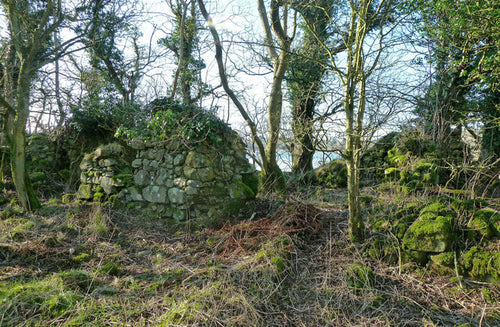
Martnaham Castle
he ruins of an old castle built on an island, recorded as Martnam Ynch (sic), near the centre of the loch are still apparent (NS 3952 1732), the entrance having been from the south side of the loch, formed by a stone embankment or causeway from the land to the island. It is not clear when it was erected. It was inhabited till the 16th century. The remains are of a large building, 21m by 7.5m, and the foundations of an annexe, 12m by 5m, were visible to the north-east. The main block is divided into three compartments, and the walls are of mortared rubble masonry, 0.8m thick, and attain a maximum height of 2.0m. Architectural features suggest a 16th/17th century date. A possible rectangular building at the approach to the causeway may indicate the previous presence of a gatehouse. The site has been densely wooded for many years.
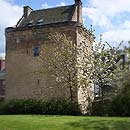
Newmilns Tower
Newmilns Tower is a simple 16th century tower measuring 30ft by 24ft over walls 5ft in thickness. he Tower is believed to have been built as a keep or strong house for the Campbells of Loudoun when Loudoun Castle had been sacked in a retaliation raid by the Kennedys of Dunure. The building has served as a prison for covenanters and in its last years before restoration housed the Newmilns Town Band. The project included detailed archaeological investigations, structural repairs, fitting out the house and landscaping to provide a modern interpretation of a 17th century garden. Works were undertaken between 1994 and 1996 with funding from the Architectural Heritage Fund, Scottish Development Agency, Scottish Department, Historic Scotland and Enterprise Ayrshire. On completion the house was sold as a private dwelling.

Polkelly Castle Tower
also known as 'Pokelly', this was an ancient castle located near Fenwick. Part of the Barony of Polkelly. The name is given around 1564 as Powkellie when it was held by the Cunninghams of Cunninghamhead.
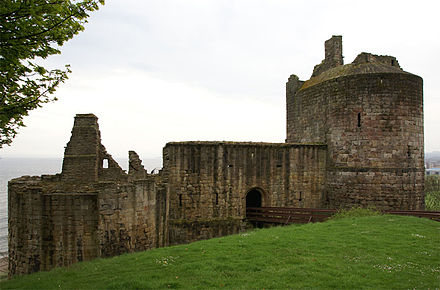
Ravenscraig Castle
Located in Kirkcaldy Ravenscraig dates back to around 1460 Ravenscraig Castle is now a ruin which sits at the West End of Ravenscraig Park .

Riccarton Castle
Riccarton Castle is in the parish of Riccarton. William Wallace himself was born in Riccarton. After his murder of Selby, Governor of Dundee, William Wallace first sought refuge in Riccarton castle
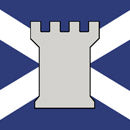
Robertland Castle
Only a few stones still exist to mark the position of Robertland Castle. The Castle is situated in the barony of Robertland, around 1.5 miles north-east of Stewarton. It and was held by a cadet branch of the Cunninghames. The Montgomeries are believed to have burnt the castle down following the murder of the 4th Earl of Eglinton at Stewarton in 1586.
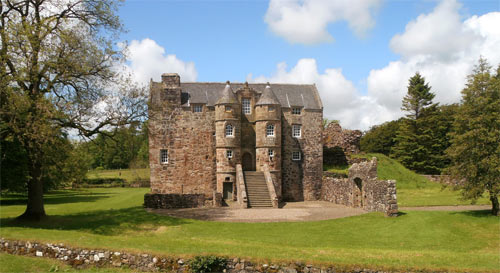
Rowallan Castle
Rowallan Castle is an ancient castle located near Kilmaurs. Picture kindly supplied by Robert B. More, FSA Scot. High Commissioner, NW United States Clan Muir Society. The castle is thought to date back to the 13th Century and has been owned or held by the medieval Muir family, the (Boyle) Earls of Glasgow, the (Campbell) Earls of Loudoun, and the (Corbett) Barons Rowallan. In 1989, it returned to the Campbell family
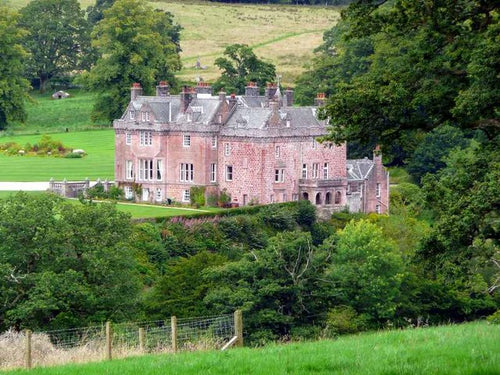
Sorn Castle
The castle is just outside the village of Sorn beside the River Ayr. It is thought to date back to the 15th Century. In the 1860s the Somervell family owned the castle. Sorn Castle was bought in 1908 by Thomas W. McIntyre.
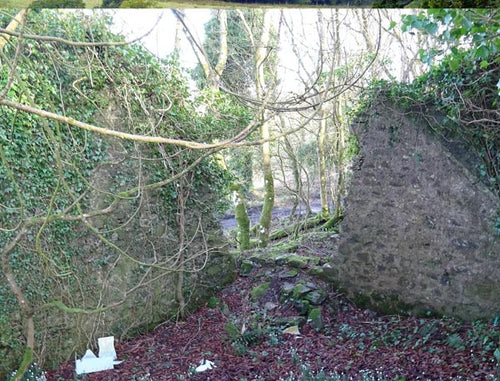
Templehouse
Part of the Parish of Templehouse, Templehouse is now just ruins, It was first held, under the Knights Templars, as part.of the lands of the Templelands of Dunlop Hill by their vassals, the Gemmell or Gemmill family who remained in occupation for around 500 years. The last of the line was Minnie Gemmell who died in 1962 and as no heir was found the buildings fell into ruins.
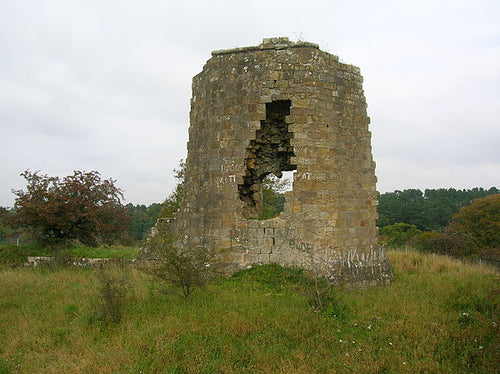
Terringzean Castle
Terringzean Castle, also Taringzean, pronounced 'Tringan', is a Category B listed castle ruin lying above the River Lugar and the Terringzean Holm in the policies of Dumfries House, Parish of Cumnock, Scotland. The name Craufordstone or Craufurdstoun, has also been used, echoing that it and these lands originally belonged to the Crawfords,.

Trabboch Castle
Now ruinous, Trabboch Castle was an L Plan Tower House within the parish of Stair. King Robert the Bruce gave the castle to the Boyds of Kilmarnock for services rendered at the Battle of Bannockburn in 1314.
North Ayrshire
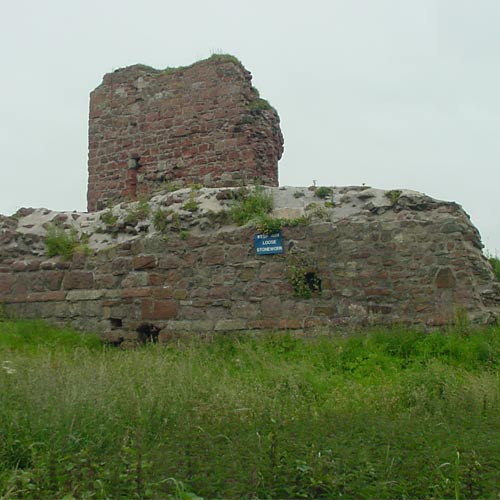
Ardrossan Castle
This castle is situated in the town of Ardrossan. The Keep dates from the 15th Century. The original castle, owned by Clan Barclay, was partly destroyed during the Wars of Scottish Independence. Rebuilt by Clan Montgomery in the 15th century, Ardrossan later fell into disuse and was partially demolished by the soldiers of Oliver Cromwell in the 17th century who used the stones to help construct the Ayr Citadel.
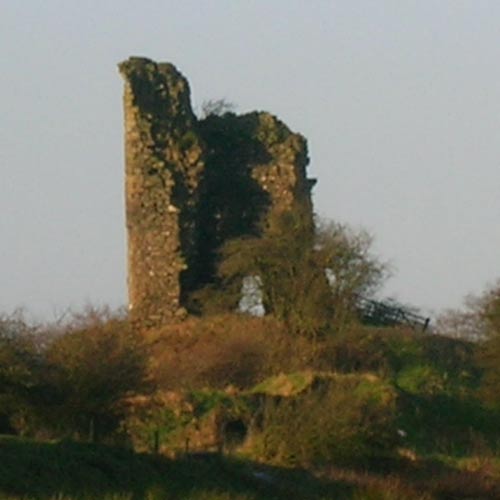
Auchenharvie Castle
Auchenharvie Castle is a ruined keep near Torranyard. belonged to David Cunningham, 1st Baronet of Auchenharvie, an absentee courtier in England, till 1642 . It has stayed within Cunningham hands for a long time.

Hill of Beith Castle
The old Barony and castle, fortalice, or tower house of Hill of Beith lay in the feudal Regality of Kilwinning, within the Baillerie of Cunninghame, and the Sherrifdom of Ayr, now the Parish of Beith, North Ayrshire, Scotland.
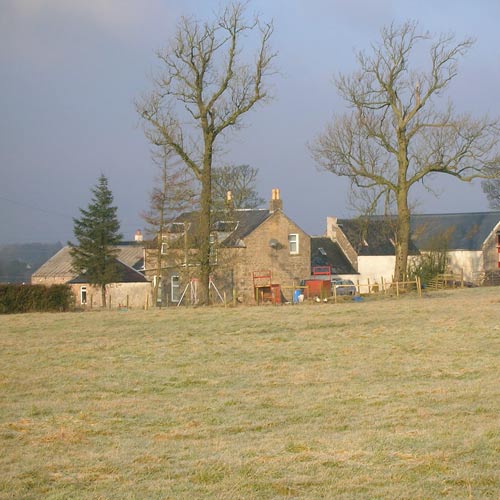
Broadstone Castle
Broadstone Castle exists no more, it would have been close to the small village of Gateside in North Ayrshire, about half a mile east of Beith in the old Barony of Giffen. There is a farmhouse close to it's original position. There were ruins until 1850. This would have been the Montgomerie then the Shaws.

Brodick Castle
Brodick Castle is situated in The port of Brodick on the Isle of Arran, an island in the Firth of Clyde. It was previously the Seat of the Duke of Hamilton.
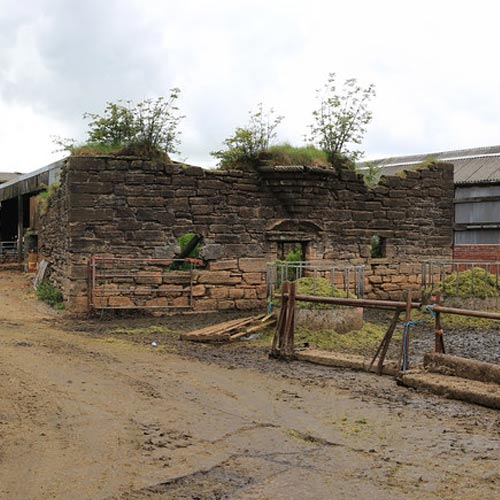
Clonbeith Castle
The ruinous remains of The Castle of Clonbeith lie in fairground. It was the old feudal Baillerie of Cunninghame, near Auchentiber.
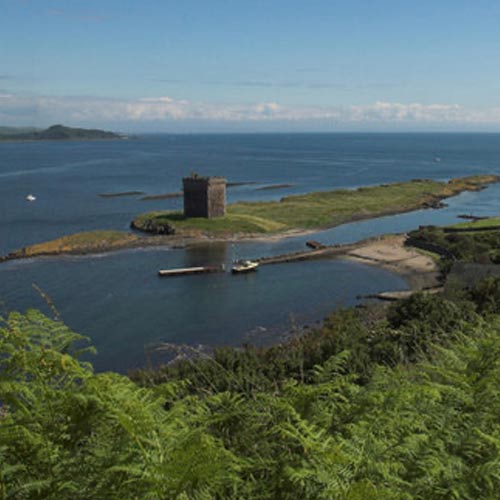
Little Cumbrae Castle
Little Cumbrae Castle sits on Allimturrail (the islet of the noble's tower) a small tidal island, situated off the east coast of Little Cumbrae. Records of a castle here go back to the 1300s. The present small square castle of Little or Lesser Cumbrae was built by Lord Eglinton in the 16th century.
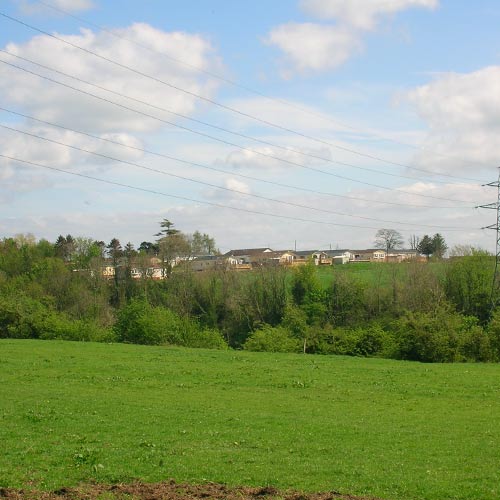
Cunninghamhead Castle
Cunninghamhead Castle was a tower belonging to the Cunninghams although nothing of it now remains. It was demolished by John Snodgrass in 1747 when a mansion house was built
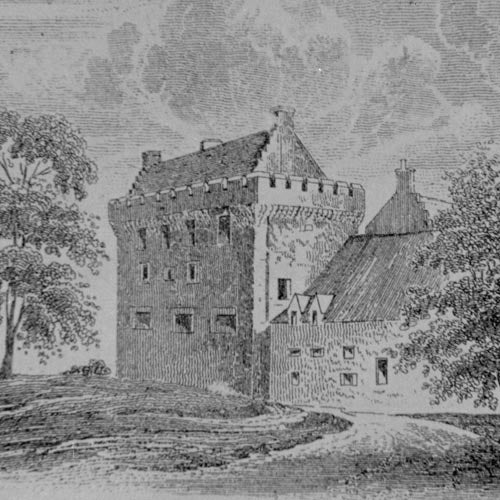
Eglinton Castle
The ancient seat of the Earls of Eglinton, it is located just south of the town of Kilwinning. The original Eglinton Castle was burnt by the Earl of Glencairn in 1528.
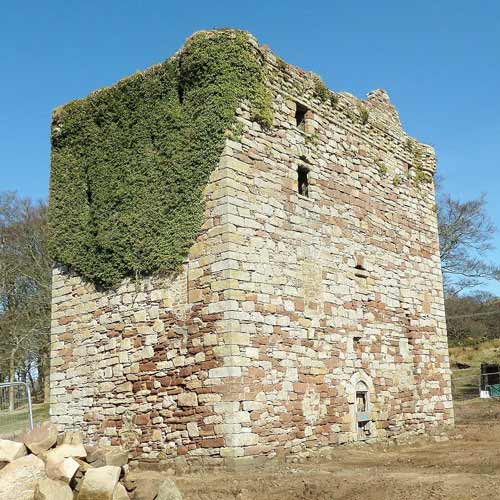
Fairlie Castle
Fairlie Castle is a restored oblong tower castle located on a natural rounded knoll situated above a precipitous section of the Fairlie Glen near the town of Fairlie in the old Barony of Fairlie, Parish of Largs. Sir Robert Fairlie of that Ilk built the present castle in 1521. In around 1656-1660[12] the last of the Fairlie family sold the castle and barony to the Boyle family in the person of David, first Earl of Glasgow.
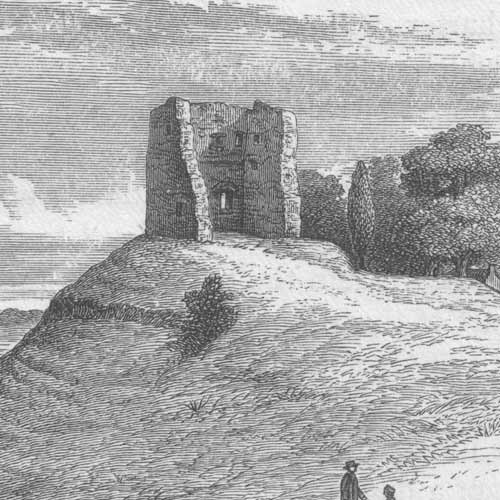
Giffen castle
This was a 15th-century castle were in the parish of Beith in the former District of Cunninghame. Associated with The Barony of Giffen. The castle was acquired by Sir John Anstruther in the early 18th-century and he is responsible for allowing it to become a ruin,
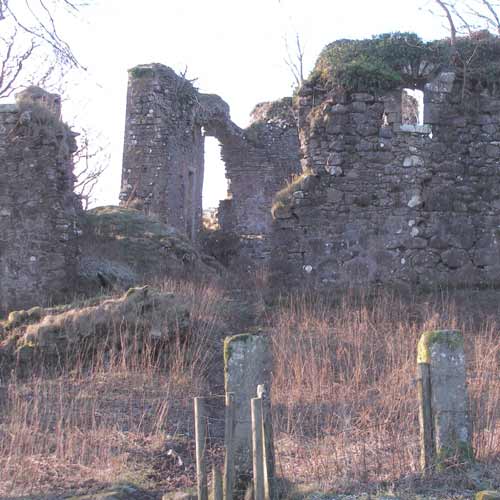
Glengarnock Castle
Glengarnock Castle is located on a remote rocky promontory overlooking the River Garnock about 2 miles north of the town of Kilbirnie. here is no clear account of when this was erected or by whom, but it may have been built by the Cunningham (or Cunninghame) family or by the Riddels who preceded them. The Barony of Glengarnock is one of three feudal baronies which together form the parish of Kilbirnie in the district of Cunningham.

Hessilhead Castle
Hessilhead is in Beith. This was part of the Lordship of Giffen, and the Barony of Hessilhead, within the Baillerie of Cunninghame and the Parish of Beith.

Kelburn Castle
Kelburn Castle is a large house near Fairlie, The Boyle family have been in possession of the lands of Kelburn since the 12th century. Originally built in the thirteenth century (the original keep forms the core of the house) it was remodelled in the sixteenth century. Kelburn’s castle was painted in 2007 and is now recognised as one of the world’s top 10 examples of street art by author and designer Tristan Manco.
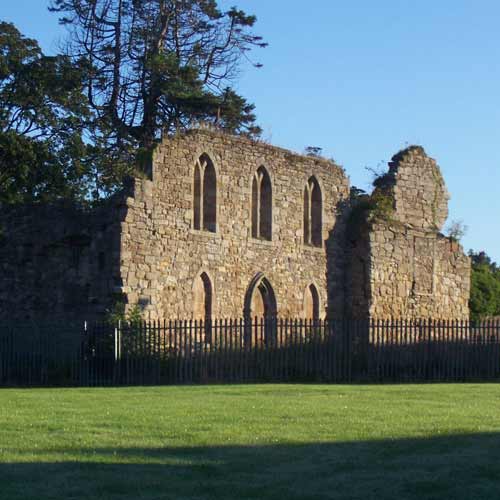
Kerelaw Castle
Situated in the town of Stevenston, Kerelaw Castle is a castle ruin owned by surviving male descendant of the Hamilton family, Logan Neely. It has been owned by the Lockharts and the barony were eventually passed on to the Campbells of Loudoun and later to the Cunninghames of Kilmaurs. It was in the Cunninghame's possession in 1488 that the castle was sacked and burned by the 2nd Lord Montgomerie

Kersland Castle Tower
Situated on stood on Easter (now 'East') Kersland Farm. The castle would have been associated with The Barony of Kersland which was once extensive, however after the days of the Kerrs the land was parcelled out and the mid-superiority purchased by John Smith of Swineridgemuir (sic) after having been held by the Kerr family for upwards of 500 years.

Kilbirnie Place Tower
The remains of Kilbirnie Place Tower lie west of the town of Kilbirnie, in the old Barony of Kilbirnie. Kilbirnie Castle is said to be the site where in 1263 the Scots mustered under Alexander III before fighting Norwegian forces in the Battle of Largs. A large part of this was built by Malcolm Crawfurd and his wife, Marjory Barclay. The Honourable Patrick Lindsay purchased the castle and estate of Glengarnock in 1677 from Richard Cuninghame, the last of the Cuninghames of the Barony of Glengarnock.

Kildonan Castle
Kildonan Castle stands in the small village of Kildonan, Arran. The castle's name is derived from the name of a former resident, Saint Donan, who is said to be buried on the island. It was built in the 13th century by the MacDonalds, the Lords of the Isles. The castle stands on the cliffs, overlooking the island of Pladda and the entrance to the Firth of Clyde. It was built to defend against enemies attacking through the Firth. It was used as a hunting lodge by the Kings of Scotland, including Robert III, when the island belonged to the crown. The castle became the property of the Earls of Arran in 1544.
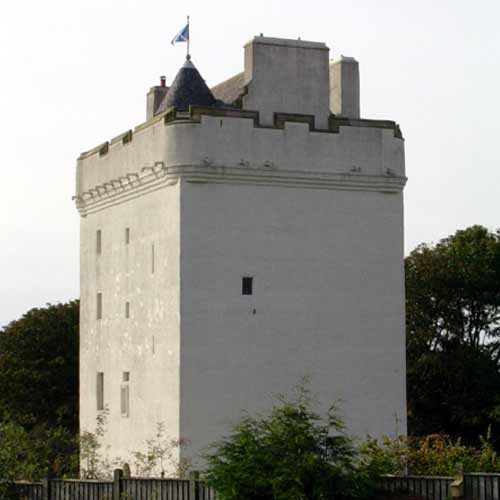
Law Castle
Law Castle is situated slopes of Law Hill on the edge of West Kilbride. It was built for Princess Mary, sister of King James III, as a wedding gift upon her marriage in 1467 to Thomas Boyd, Earl of Arran. After many years of failed restoration projects it was finally bought by David Hutton, who completed the restoration in 2005.

Lochranza Castle (Arran)
Lochranza Castle is situated beside the stunning Loch Ranza in the north of Arran. Most of the castle was built in the 16th century but parts date back to the 13th century when it was owned by the MacSweens. In 1262, King Alexander III granted the castle and its lands to Walter Stewart, the Earl of Menteith. By 1371, the castle was the property of Robert II.It is thought that at this time it was used as a royal hunting lodge. In 1600 Robert Montgomerie of Skelmorlie recovered the castle for the Marquess of Hamilton from Alastair Mc Alastair and his followers. In 1614 it was occupied by the king and in the 1650s it was used by Cromwell. By 1705, Lochranza Castle was the property of the Hamilton family, after it was purchased by the Duchess of Hamilton. They then sold it to the Blackwood-Davidson family who used it as their principal seat. During the 18th century, the castle fell into disuse and was abandoned. The castle is now in the care of Historic Scotland.
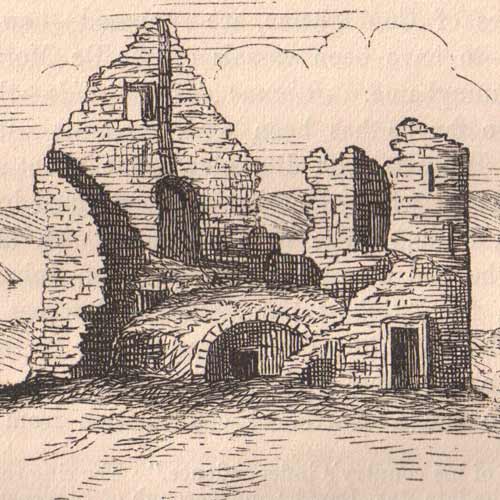
Montfode Castle
The remains of the old castle lie to the north-west of the town of Ardrossan and 1.5 miles from West Kilbride. he name 'Montfode' comes from an old Norman family of that name, the Montfodes of that Ilk. The Barony was originally held by the powerful De Morville family and the Montfodes would have been their vassals. The castle was mostly demolished in the early 19th century
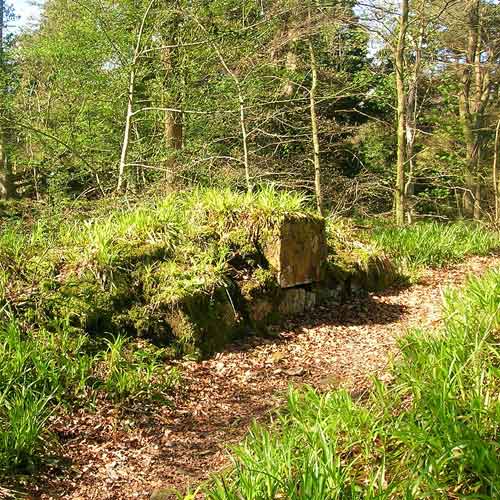
Montgreenan Castle
The ruins of the old Montgreenan Castle or Bishop's Palace lie in a loop of the Lugton Water at its confluence with the Cowlinn Burn. This would have been within the ancient county of Cuninghame.
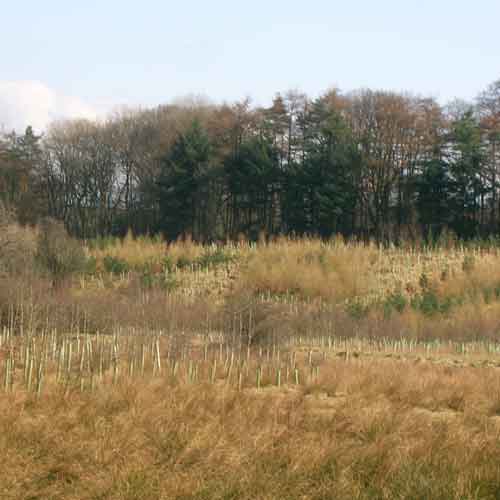
Pitcon Fortified tower
Pitcon is in the parish of Dalry. I am unable to find any information on this tower.
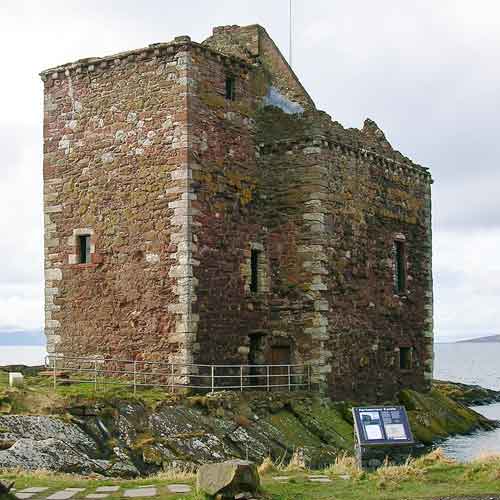
Portencross Castle
The castle is situated in Portencross. about 3 km from West Kilbride. The site has been fortified since the 11th Century. The present tower castle is thought to date from the mid-14th Century and later. It remained in use until it was unroofed by a great storm in 1739 and gradually became ruinous. This has been a Boyd Family residence.

Roughwood Tower
Roughwood Tower stood in the parish of Beith, it was a simple fortified keep. the lands lay within the old Lordship of Giffen.The history of RoughwoodThe name 'Ruch' in Scot's relates to ground that is "difficult to traverse; broken, uneven; covered with tussocky vegetation or the like".

Seagate Castle
Seagate Castle is in the Royal Burgh of Irvine. The castle was formerly a stronghold of the Montgomery Clan.
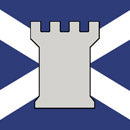
Shewalton Castle
This was a Tower Castle. It was situated within the Shewalton Estate, the lands had been held by the Fullartons of that Ilk and by 1545 they were home to the Wallace family. Then finally being sold to The Earl of Glasgow. The Lairds of Shewalton were the Fullartons and Wallaces.
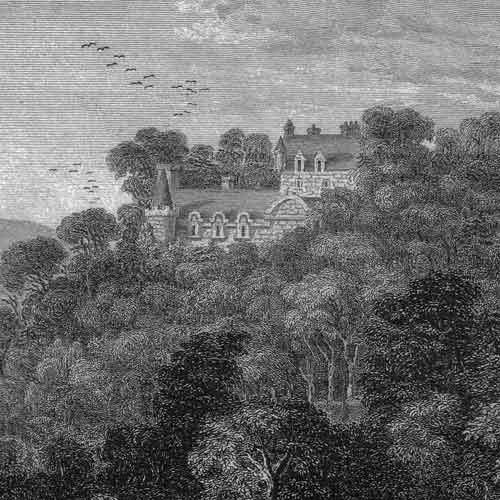
Skelmorlie Castle
Skelmorlie Castle stands on the eastern shore of the Firth of Clyde. The structure dates from 1502, and was formerly the seat and stronghold of the Montgomery Clan. During the reign of Robert III (1390–1406) the lands of Skelmorlie were held by the Cunninghames of Kilmaurs; in about 1460 the northern portion passed into the hands of the Montgomeries as Skelmorlie-Montgomerie.
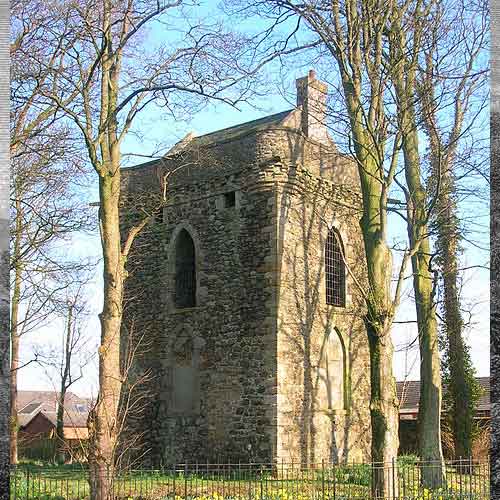
Stanecastle
Stanecastle was a medieval barony and estate. The original castle was built circa 1417 by the Francis family, who also held land at Sprouston near Kelso. The barony passed by marriage to the Montgomerys of Greenfield. It passed to The Earls of Eglinton in the 15th century.
South Ayrshire

Auchans Castle
The ruins of Auchans Castle stand in Donald. It was a 16th Century L Plan Castle. This has been owned by the Wallace, Cochrane and Montgomerie families.
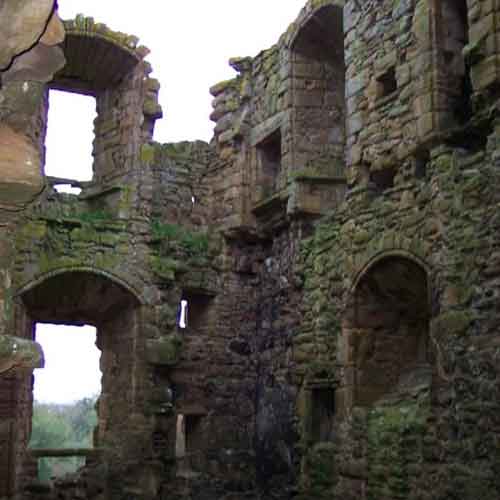
Baltersan Castle
Baltersan Castle is a ruined L-plan tower house located near Maybole. The site was originally occupied by Baltersan House, owned by Egidia Blair, Lady Row, who died in 1530. After her death, the house was demolished. In 1721, the castle passed into the hands of Captain Hugh Arbuthnot, cousin to John Kennedy of Baltersan. By the middle of the 18th century, the castle had become abandoned and remains so to the present day.
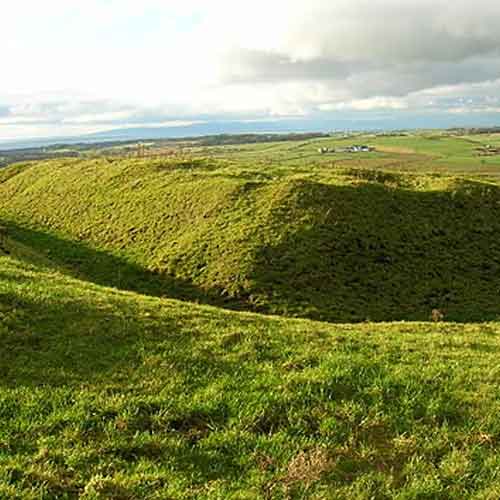
Barnweill Castle
Barnweill Castle was a castle located at Barnweill, in the parish of Craigie, South Ayrshire, Scotland. The castle was a stronghold of the Lindsay family. A rectangular moat is located around the motte, the caput of the Barony of Barnweill.
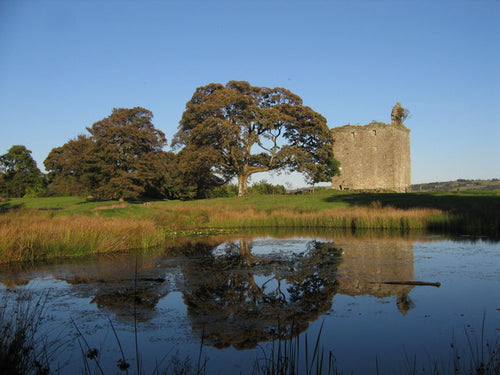
Barr Castle
Barr Castle or Barr Tower is a late medieval tower house. It can be seen today as a ruin on a low ridge to the south of the village of Lochwinnoch, Renfrewshire. Barr Castle was constructed in the 15th or early 16th century. It passed into the hands of the Hamiltons of Ferguslie at the end of the 16th century. They retained the castle until the late 18th century, when they sold and abandoned it for a new mansion.
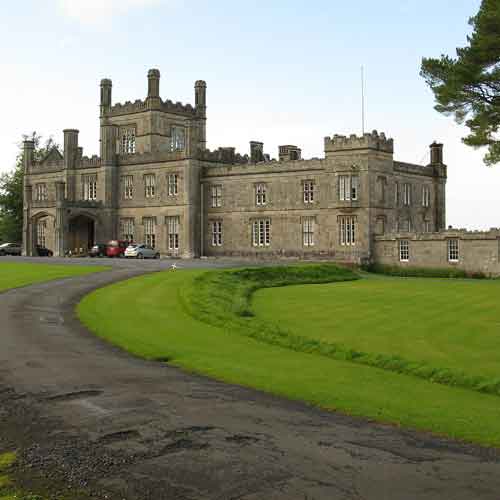
Blairquhan Castle
Blairquhan Castle is a Regency era castle near Maybole. Four different families have lived at Blairquhan or on its lands. The McWhirters built the first tower house about 1346. The Kennedys then inherited the estate. In the early 17th century the Whitefords took over who then sold the castle to Sir David Hunter Blair, 3rd Baronet who had married Jean Blair. The family took the surname Blair. The old castle, which had become ruinous due to previous fires and neglect, was torn down for a new the Tudor-style castle
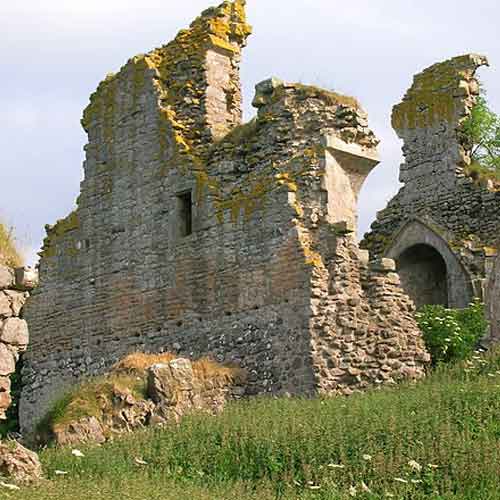
Craigie Castle
Craigie Castle is a ruined fortification in the old Barony of Craigie. The castle is recognised as one of the earliest buildings in the county. was originally built for the Lyndesay or Lindsay clan. The castle passed to John Wallace of Riccarton through marriage about 1371 as the last heir was a daughter. This line of the Ayrshire Wallaces then lived at Craigie Castle until they moved to Newton Castle in Ayr in 1588. Craigie Castle was then left to fall into ruin.
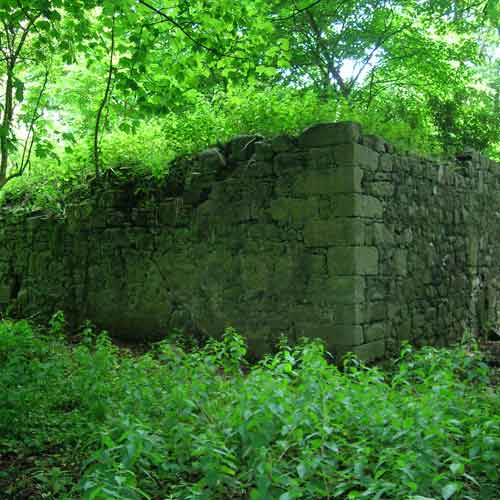
Crosbie Castle
The remains of the Castle and Estate lie near Troon. The site was the home of the Fullarton family for several centuries. The lands were part of the feudal Barony of Corsbie Fullartoune (sic).

Culzean Castle
The majestic Culzean Castle is situated near Maybole, Carrick. It is the former home of the Marquess of Ailsa, the chief of Clan Kennedy, but is now owned by the National Trust for Scotland. Culzean Castle was constructed as an L-plan castle by order of the 10th Earl of Cassilis.
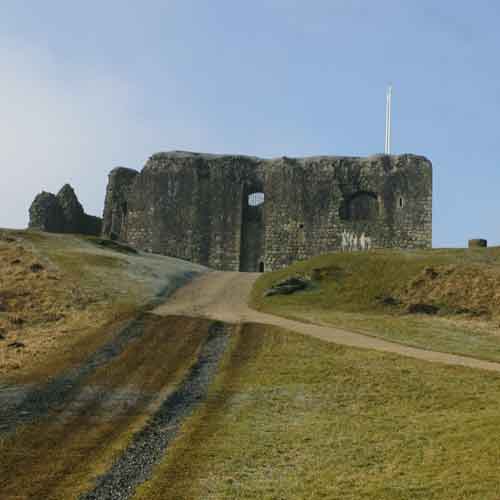
Dundonald Castle
Built in 1370s, by Robert II, Dundonald Castle Dundonald Castle is an impressive sight. By 1520 the castle had passed to the Wallaces of Craigie. The family held onto it, although in 1536 king James V granted the castle and the lands to Robert Boyd. It then passed back to the Wallace Family. Who then sold it to James Mathieson. The Wallaceshad abandoned the castle and moved to Auchens House. Both the House and the Castle were then bought by Sir William Cochrane in 1638. In 1669 Cochrane was created the first Earl of Dundonald for his support to the Royalist cause in the Wars of the Three Kingdoms.
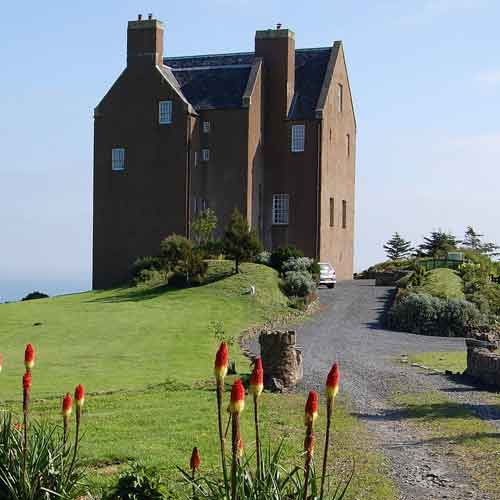
Dunduff Castle
Dunduff Castle or Tower is a restored stair-tower built on the hillside of Brown Carrick Hills above the Drumbane Burn near he village of Dunure. It is recorded that Sir John de Graham was born on the lands of Dunduff in 1298. The first Laird of Dunduff was William Stewart, married to Isobel Ker.
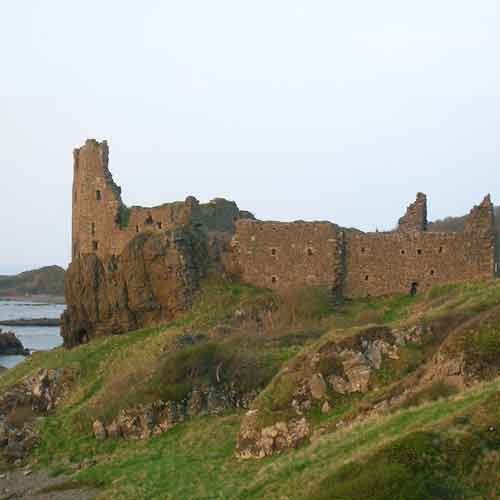
Dunure Castle
Dunure Castle is located around 5 miles from Ayr,on a rocky promontory on the Carrick coast, overlooking the small harbour of Dunure.

Fail Castle
Built around the 16th Century, Fail Castle is situated in Tarbolton. It resided on Estates owned by the Monastery.
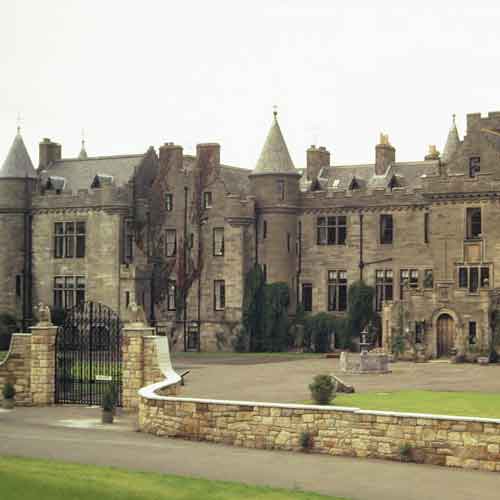
Glenapp Castle
Now a luxury hotel, Glenapp Castle was formerly the family seat of the Earl of Inchcape. The castle was built for the Deputy Lord Lieutenant of the County, James Hunter. It is situated near Ballantrae and overlooks several islands. The Inchcape family owned the castle from 1917 until the early 1980s
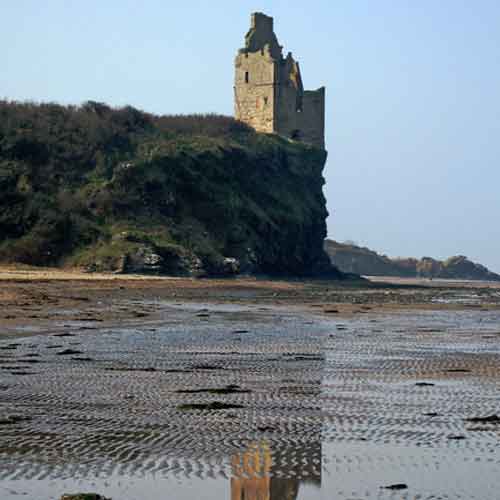
Greenan Castle
Greenan Castle is a 16th-century ruined tower house, situated on a sea cliff, just over 2 miles outside of Ayr. In the 12th Century it was a Fort then in the 15th century a tower house was built by the Lords of the Isles, which later passed into the hands of the Kennedy family.
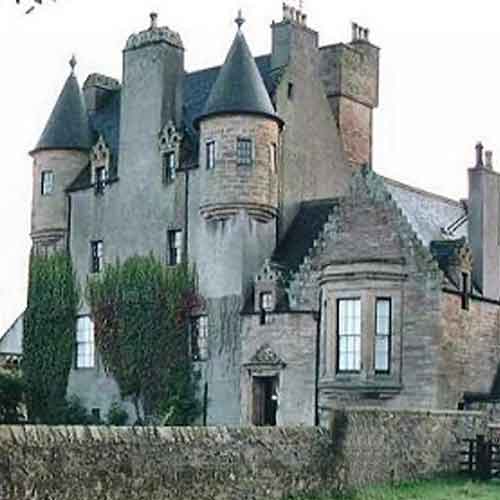
Maybole Castle
Maybole Castle is in the village of Maybole. It is a 16th-century L-plan tower house. The tower was probably built by Gilbert Kennedy, 5th Earl of Cassillis, and High Lord Treasurer of Scotland.
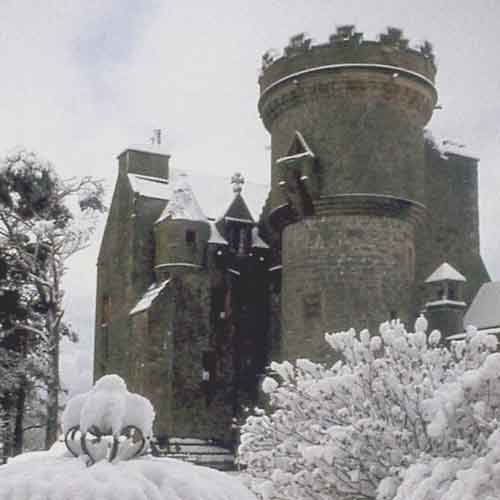
Penkill Castle
Penkill Castle is a 16th-century castle, built by a branch of the Boyd family.
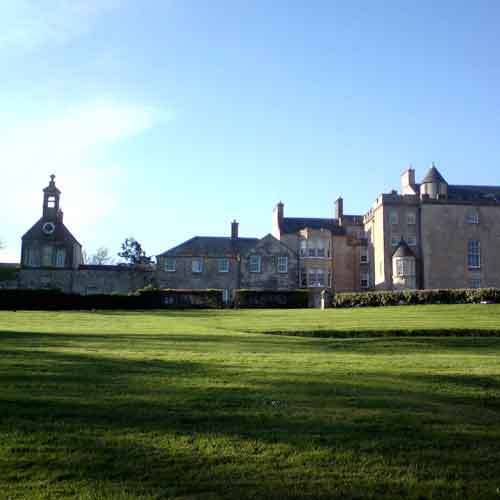
Sundrum Castle
Sundrum Castle is located 1.5 kilometres from Coylton, by the Water of Coyle. The original castle was built in the 14th century by Sir Robert Wallace, Sheriff of Ayr. This was incorporated into the present mansion, built by the Hamiltons of Sundrum in 1792.
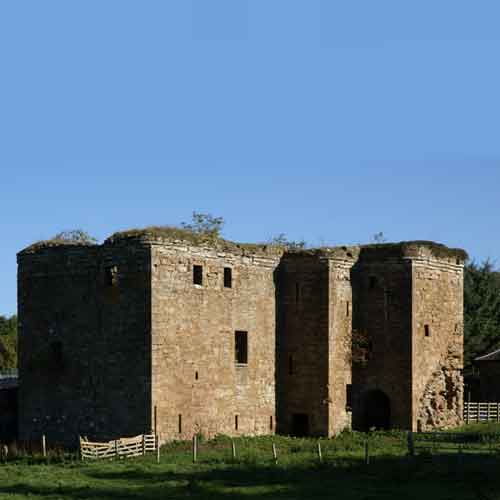
Thomaston Castle
Thomaston Castle is a medieval castle located west of Maybole. Thomaston Castle was originally built in the 13th century for a nephew of Robert The Bruce, and first owned by Alan McIlvaine (b. 1500 in Ayrshire) whose family supplied wine to the Earls Kennedy, owners of nearby Culzean Castle. Upon his death, Thomaston passed to Patrick McIlvaine on his marriage to Isobel Kennedy, a daughter of Gilbert Kennedy, 3rd Earl of Cassilis.
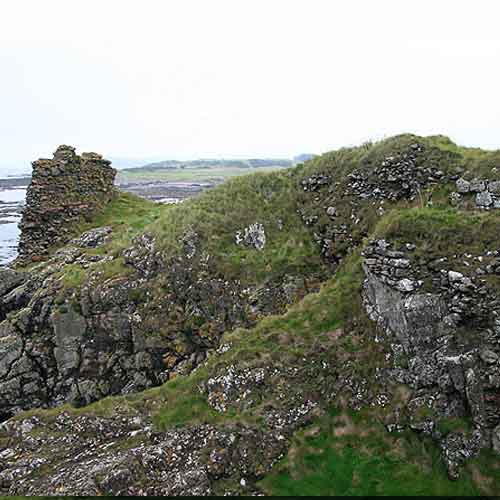
Turnberry Castle
Turnberry Castle is a fragmentary ruin on the coast of Kirkoswald parish, near Maybole. It was the seat of the Earls of Carrick. Originally a stronghold of the Lords of Galloway, Turnberry Castle then passed into the possession of the Earls of Carrick around the beginning of the 13th century
